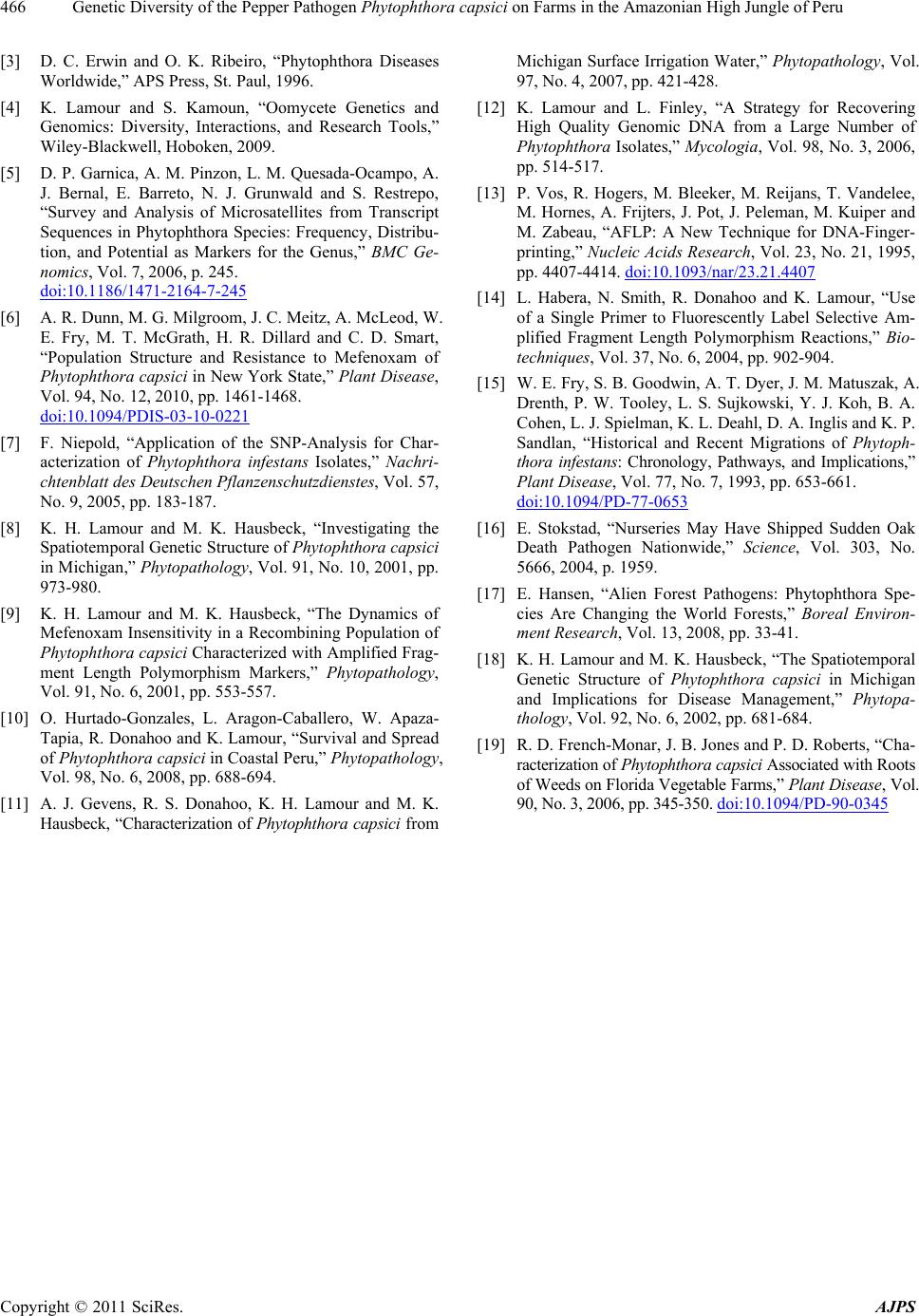
Genetic Diversity of the Pepper Pathogen Phytophthora capsici on Farms in the Amazonian High Jungle of Peru
466
[3] D. C. Erwin and O. K. Ribeiro, “Phytophthora Diseases
Worldwide,” APS Press, St. Paul, 1996.
[4] K. Lamour and S. Kamoun, “Oomycete Genetics and
Genomics: Diversity, Interactions, and Research Tools,”
Wiley-Blackwell, Hoboken, 2009.
[5] D. P. Garnica, A. M. Pinzon, L. M. Quesada-Ocampo, A.
J. Bernal, E. Barreto, N. J. Grunwald and S. Restrepo,
“Survey and Analysis of Microsatellites from Transcript
Sequences in Phytophthora Species: Frequency, Distribu-
tion, and Potential as Markers for the Genus,” BMC Ge-
nomics, Vol. 7, 2006, p. 245.
doi:10.1186/1471-2164-7-245
[6] A. R. Dunn, M. G. Milgroom, J. C. Meitz, A. McLeod, W.
E. Fry, M. T. McGrath, H. R. Dillard and C. D. Smart,
“Population Structure and Resistance to Mefenoxam of
Phytophthora capsici in New York State,” Plant Disease,
Vol. 94, No. 12, 2010, pp. 1461-1468.
doi:10.1094/PDIS-03-10-0221
[7] F. Niepold, “Application of the SNP-Analysis for Char-
acterization of Phytophthora infestans Isolates,” Nachri-
chtenblatt des Deutschen Pflanzenschutzdienstes, Vol. 57,
No. 9, 2005, pp. 183-187.
[8] K. H. Lamour and M. K. Hausbeck, “Investigating the
Spatiotemporal Genetic Structure of Phytophthora capsici
in Michigan,” Phytopathology, Vol. 91, No. 10, 2001, pp.
973-980.
[9] K. H. Lamour and M. K. Hausbeck, “The Dynamics of
Mefenoxam Insensitivity in a Recombining Population of
Phytophthora capsici Characterized with Amplified Frag-
ment Length Polymorphism Markers,” Phytopathology,
Vol. 91, No. 6, 2001, pp. 553-557.
[10] O. Hurtado-Gonzales, L. Aragon-Caballero, W. Apaza-
Tapia, R. Donahoo and K. Lamour, “Survival and Spread
of Phytophthora capsici in Coastal Peru,” Phytopathology,
Vol. 98, No. 6, 2008, pp. 688-694.
[11] A. J. Gevens, R. S. Donahoo, K. H. Lamour and M. K.
Hausbeck, “Characterization of Phytophthora capsici from
Michigan Surface Irrigation Water,” Phytopathology, Vol.
97, No. 4, 2007, pp. 421-428.
[12] K. Lamour and L. Finley, “A Strategy for Recovering
High Quality Genomic DNA from a Large Number of
Phytophthora Isolates,” Mycologia, Vol. 98, No. 3, 2006,
pp. 514-517.
[13] P. Vos, R. Hogers, M. Bleeker, M. Reijans, T. Vandelee,
M. Hornes, A. Frijters, J. Pot, J. Peleman, M. Kuiper and
M. Zabeau, “AFLP: A New Technique for DNA-Finger-
printing,” Nucleic Acids Research, Vol. 23, No. 21, 1995,
pp. 4407-4414. doi:10.1093/nar/23.21.4407
[14] L. Habera, N. Smith, R. Donahoo and K. Lamour, “Use
of a Single Primer to Fluorescently Label Selective Am-
plified Fragment Length Polymorphism Reactions,” Bio-
techniques, Vol. 37, No. 6, 2004, pp. 902-904.
[15] W. E. Fry, S. B. Goodwin, A. T. Dyer, J. M. Matuszak, A.
Drenth, P. W. Tooley, L. S. Sujkowski, Y. J. Koh, B. A.
Cohen, L. J. Spielman, K. L. Deahl, D. A. Inglis and K. P.
Sandlan, “Historical and Recent Migrations of Phytoph-
thora infestans: Chronology, Pathways, and Implications,”
Plant Disease, Vol. 77, No. 7, 1993, pp. 653-661.
doi:10.1094/PD-77-0653
[16] E. Stokstad, “Nurseries May Have Shipped Sudden Oak
Death Pathogen Nationwide,” Science, Vol. 303, No.
5666, 2004, p. 1959.
[17] E. Hansen, “Alien Forest Pathogens: Phytophthora Spe-
cies Are Changing the World Forests,” Boreal Environ-
ment Research, Vol. 13, 2008, pp. 33-41.
[18] K. H. Lamour and M. K. Hausbeck, “The Spatiotemporal
Genetic Structure of Phytophthora capsici in Michigan
and Implications for Disease Management,” Phytopa-
thology, Vol. 92, No. 6, 2002, pp. 681-684.
[19] R. D. French-Monar, J. B. Jones and P. D. Roberts, “Cha-
racterization of Phytophtho ra capsici Associated with Roots
of Weeds on Florida Vegetable Farms,” Plant Disease , Vol.
90, No. 3, 2006, pp. 345-350. doi:10.1094/PD-90-0345
Copyright © 2011 SciRes. AJPS